
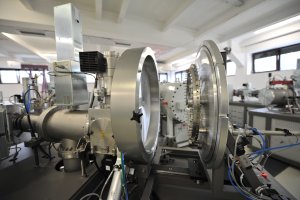
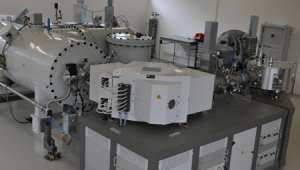
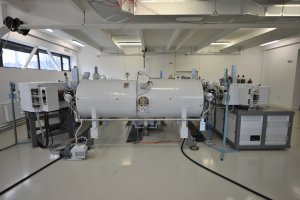
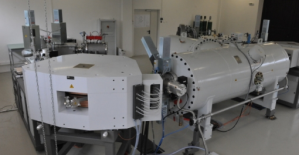
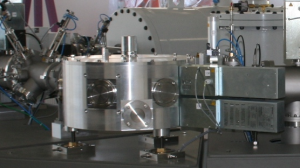

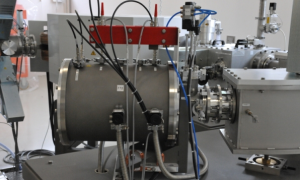
AMS setup with 1 MV Cockroft-Walton Tandetron Accelerator
Contact person: Tiberiu Sava
Accelerator Mass Spectrometry (AMS) is a technique for measuring long-lived radionuclides that occur naturally or anthropogenically in our environment. AMS uses a particle accelerator in conjunction with ion sources, large magnets, and detectors to separate out interferences and count single atoms in the presence of 1x1015 (a thousand million million) stable atoms. At RoAMS we measure different cosmogenic and anthropogenic radionuclides (14C, 10Be, 26Al, 129I, 239,240Pu). They are used for a wide variety of dating and tracing applications in the geological and planetary sciences, archaeology, and biomedicine.
Cs sputtering ion source
The ion source produces a beam of ions (with -1 electrical charge) from a few milligrams of solid material. Atoms are sputtered from the sample by 133Cs ions which are produced on a hot spherical ionizer. Very few samples are directly measured into the AMS spectrometer, usually they have to suffer a chemical pre-treatment. In case of 14C, the CO2 from the solid/liquid sample is converted into graphite after a combustion or digestion into a specific apparatus, function of the sample type. We have two 50 samples ion sources, one dedicated only to radiocarbon dating and the second for the other isotopes. Negative ions produced on the surface of the sample are extracted from the ion source and sent down the evacuated beam line towards the first electrostatic analyzer (ESA).
Injector magnet (bouncer)
The injector magnet bends the negative ion beam by 90 degrees to select the mass of interest according to their magnetic rigidity. It has a bouncer system, meaning it is able to switch between different ion species (ex: carbon 12, 13 and 14) in rapid sequence. This is realized by applying a high voltage on the magnet chamber, accelerating and decelerating the different mass ions in order to maintain their 90 degrees trajectory towards the accelerator tank.
1 MV Cockroft-Walton Tandetron Accelerator
This is a type of electrostatic linear accelerator that accelerates ions in a uniform electrostatic field with a maximum electric potential of 1MV supplied by a Cockroft-Walton high voltage generator. In a Tandem system the high positive potential is applied to a central electrode in the middle of the accelerator tank. Negative ions are injected into the accelerator and gain energy towards the middle positive potential. Arriving here, negative ions are stripped of electrons by collisions with a stripping gas (argon) and turn positive. Once positive they are further pushed by the high positive potential and exit the accelerator, gaining energy function of their charge state.
The analyzing magnet
After the stripping process inside the accelerator, the ion beam is split into several components having different charge states and thus gaining different energies, in the domain of MeV. Analyzing magnet selects ions with the same p/q (momentum/charge state) ratio using two sets of micrometric slits and further deflects them to 90 degrees. This way one can isolate a particular ion species, i.e. isolating carbon 13 from all other species composing the beam, so the analyzing magnet basically acts as a ion filter.
Low-energy electrostatic analyzer (ESA)
At our AMS system we have installed two such electrostatic analyzers, one on the low energy side and the second on the high energy side. An ESA analyzer is using an electric field sector created by two curved polarized plates. Basically an ESA is selecting the passing particles according to their energy, the lower the energy of the ion beam, the lower is the applied voltage. The main function of the low energy ESA is to switch between the two ion sources, the other being the energy selection.
High-energy ESA
The high-energy electrostatic analyzer (ESA) selects ions with the same (E/q) and thus removing the ions that happen to receive the wrong energy from the accelerator and the molecular fragments surviving the stripping and the 90 degree analysis. It is used to further purify the beam and ensure a minimum presence of contaminants. This ESA is placed on the rare isotope beam line, so that it acts like a last filter before the particle detector.
Gas ionization chamber
The rare isotope beam is finally measured into a gas detector holding two anodes. The detector is functioning like an E-DE telescope, with which the energy loss can be represented against the remnant energy and thus obtaining particular spectra for specific elements. Basically this instrument is discriminating the chemical elements, the discrimination criteria being the atomic number Z. The combination between an analyzing magnet (A/q analysis) and E-DE detector (Z analysis) makes sufficient the measurement of rare isotopes, i.e. 14C, 10Be, 27Al, 129I, 239,240 Pu, etc.